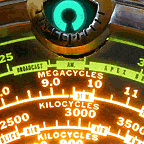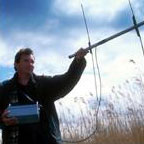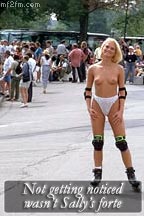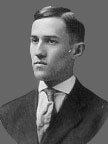Thursday 5 October, 2006, 11:39 - Spectrum Management
 Something that's always been a nuisance is that the International Telecommunications Union (ITU) has made it's frequency allocation tables (i.e. the table which shows which frequencies are allocated to which services in which countries) something that has to be paid for if you want a full copy. The 'ITU Radio Regulations' is a large set of documents that describe radio usage and the heart of it is a set of 3 regional tables that allocate frequencies to specific uses and currently costs 252 Swiss Francs (about GBP107 at today's exchange rate).
Something that's always been a nuisance is that the International Telecommunications Union (ITU) has made it's frequency allocation tables (i.e. the table which shows which frequencies are allocated to which services in which countries) something that has to be paid for if you want a full copy. The 'ITU Radio Regulations' is a large set of documents that describe radio usage and the heart of it is a set of 3 regional tables that allocate frequencies to specific uses and currently costs 252 Swiss Francs (about GBP107 at today's exchange rate).  If you just want to know whether fixed links have an allocation at 8 GHz in France, that's rather a lot to pay.
If you just want to know whether fixed links have an allocation at 8 GHz in France, that's rather a lot to pay.I was delighted, therefore, to discover that the Region 1 (Europe, Africa, the Middle East and Asiatic Russia) and Region 3 (Asia and Australasia) information can now be access for free on the web-site of telecommunications consultants 'InterConnect Communications'. Their Electronic Frequency Allocation Table (E-FAT) service allows you to query the ITU tables viewing either the whole table or just the allocations to specific services.
A similar service, but only for specific European countries (well certain CEPT members) is provided by the European Communications Office (ECO) in the form of their European Frequency Information Services (EFIS).
Dead handy!
add comment
( 1685 views )
| permalink
| related link
| 



 ( 2.9 / 15274 )
( 2.9 / 15274 )




 ( 2.9 / 15274 )
( 2.9 / 15274 )
Thursday 4 May, 2006, 09:08 - Spectrum Management
One question which many unlicensed radio users of any kind (e.g. pirate radio operators) often ask themselves is, "What are the chances of me getting caught?" Clearly there is a lot of illegal radio usage which goes on, some of it over very prolonged periods of time, or at regular intervals, so not all transmitters get closed down.Let's start by examining the tools available to the 'powers that be' which they can use to track down naughty radio transmitters. Most of the devices used would come under the umberella term of direction finding (DF) equipment, which often forms part of an overall spectrum monitoring system which logs details of all radio usage.
 The DF equipment informs the operator the direction from which a transmission is emanating. If such equipment is located in (or moved to) several locations within the coverage of a transmitter, the resulting direction measurements can be combined using triangulation and the location of the errant transmitter identified. The accuracy of such equipment varies: Fixed units can provide measurements to within +/- 1 degree whereas portable units may only have a resolution of +/- 10 degrees. With a resolution of 1 degree, it is not uncommon that the location of a transmitter can be identified to within about 500 metres, even with fixed receivers on the outskirts of the area of interest. Portable units are of more use close-in where the utmost accuracy is less important as the distances involved are much smaller and thus even +/- 10 degrees allows a transmitter to be located within 100 metres or so.
The DF equipment informs the operator the direction from which a transmission is emanating. If such equipment is located in (or moved to) several locations within the coverage of a transmitter, the resulting direction measurements can be combined using triangulation and the location of the errant transmitter identified. The accuracy of such equipment varies: Fixed units can provide measurements to within +/- 1 degree whereas portable units may only have a resolution of +/- 10 degrees. With a resolution of 1 degree, it is not uncommon that the location of a transmitter can be identified to within about 500 metres, even with fixed receivers on the outskirts of the area of interest. Portable units are of more use close-in where the utmost accuracy is less important as the distances involved are much smaller and thus even +/- 10 degrees allows a transmitter to be located within 100 metres or so.The last 100 metres become the most difficult. At this point the signal from the transmitter becomes so strong that direction finding equipment fails and the person doing the tracking has to resort to more traditional methods. By far the most useful method to find a transmitter when you are within 100 metres of it is to look! At this distance, the antenna may be easily visible - for pirate FM broadcasters, the 'double stack' aerials roughly strewn on top of tower blocks are a dead giveaway.
So tracking down illegal radio users is relatively straightforward and, for a continuous transmission, can be done in a couple of hours. Most (modern) radio regulators or administrations have the necessary equipment. Some even know how to use it. For sporadic or occasional transmissions, the authorities have to be ready to pounce, which is one of the reasons that so many pirate radio stations are only on-air at weekends when most radio enforcement officers are watching the football, playing golf or enjoying time with their families.
But there is a further question which needs asking... "What would cause the authorities to look for a transmission in the first place?" The simple answer is usually: Interference.
 If an unauthorised radio transmitter is not causing anyone a problem, it will largely go unnoticed. If, however, it is causing interference to another radio user, that user will notice and will usually go straight to the authorities. For pirate stations, this situation is ameliorated by the fact that legitimate broadcasters might see a pirate as a problem, not because of interference, but because the station is taking its listeners away and thus has the potential to damage its advertising revenue (or so they would claim). The main exception to this is in certain bands where the authorities tend to use their monitoring equipment regularly, knowing in advance that illegal operation takes place. This might include, for example, the 6.6 MHz 'Echo Charlie' illegal CB band, well known pirate short-wave frequencies, or indeed the FM band itself.
If an unauthorised radio transmitter is not causing anyone a problem, it will largely go unnoticed. If, however, it is causing interference to another radio user, that user will notice and will usually go straight to the authorities. For pirate stations, this situation is ameliorated by the fact that legitimate broadcasters might see a pirate as a problem, not because of interference, but because the station is taking its listeners away and thus has the potential to damage its advertising revenue (or so they would claim). The main exception to this is in certain bands where the authorities tend to use their monitoring equipment regularly, knowing in advance that illegal operation takes place. This might include, for example, the 6.6 MHz 'Echo Charlie' illegal CB band, well known pirate short-wave frequencies, or indeed the FM band itself.So what are the chances of being caught? Once you get noticed, the chances are relatively high. Keep your head down and don't tread on anyone's toes and you might just get away with it.
Thursday 2 March, 2006, 09:48 - Spectrum Management
Posted by Administrator
Posted by Administrator
 Spectrum administrations or radio regulators, whatever phrase you care to pick, tend to be staffed by enthusiastic and intelligent staff; after all, it's a complex field this radio malarkey. However, what most staff lack (and most would readily admit to) is any real experience or expertise in the radio spectrum itself. Why is this? Well, other than working for a regulator or a radio user (such as a mobile or broadcasting company) there are very few ways to gain any real radio skills. For example, most degrees in technology of one kind or another will cover 'telecommunications' and may even stray into 'electromagnetism' but few, if any, give any real chance to learn about the radio spectrum, how it is used and how to manage it. There are various manufacturers who offer training on their suite of spectrum management software and monitoring hardware, which is great if you happen to have their tools, otherwise it would be like learning how to ride a bike and then being given the job as a traffic cop!
Spectrum administrations or radio regulators, whatever phrase you care to pick, tend to be staffed by enthusiastic and intelligent staff; after all, it's a complex field this radio malarkey. However, what most staff lack (and most would readily admit to) is any real experience or expertise in the radio spectrum itself. Why is this? Well, other than working for a regulator or a radio user (such as a mobile or broadcasting company) there are very few ways to gain any real radio skills. For example, most degrees in technology of one kind or another will cover 'telecommunications' and may even stray into 'electromagnetism' but few, if any, give any real chance to learn about the radio spectrum, how it is used and how to manage it. There are various manufacturers who offer training on their suite of spectrum management software and monitoring hardware, which is great if you happen to have their tools, otherwise it would be like learning how to ride a bike and then being given the job as a traffic cop!Step up to the lectern then, various organisations who have put together training courses which can be taken by anyone but are aimed at giving the opportunity to learn about this fascinating subject. That being said, there are not many such organisations: in fact it would seem there are only a small handful in the world!
 The first such organisation is the National Telecommunications and Information Administration (NTIA). The NTIA runs an annual Spectrum Management Training Seminar over a one week period, however this is only open to 'U.S. Government agencies and contractor personnel nominated by Federal agencies'. With only 25 spaces, the course is always over-subscribed so the chance of getting a place is small. Not a great start! However, the NTIA, together with the United States Telecommuications Training Institute (USTTI) run another annual radio frequency spectrum management course every spring which is open to 'representatives of developing nations', who are sponsored by the U.S. government and thus can attend the course for free!
The first such organisation is the National Telecommunications and Information Administration (NTIA). The NTIA runs an annual Spectrum Management Training Seminar over a one week period, however this is only open to 'U.S. Government agencies and contractor personnel nominated by Federal agencies'. With only 25 spaces, the course is always over-subscribed so the chance of getting a place is small. Not a great start! However, the NTIA, together with the United States Telecommuications Training Institute (USTTI) run another annual radio frequency spectrum management course every spring which is open to 'representatives of developing nations', who are sponsored by the U.S. government and thus can attend the course for free! The USTTI (which is a joint U.S. Government and industry sponsored, not-for-profit organisation) also run a number of courses of varying lengths covering spectrum management and spectrum monitoring, each of which is sponsored by a manufacturer (such as Agilent, TCI or Rohde & Schwarz). The USTTI courses are provided for free, whilst participants have to cover their travel and subsistence costs, and applications have to be made 16 weeks (4 months) in advance. Nothing in life is every truly free and given the level of sponsorship which the commercial organisations must give to each event, one wonders how much of a sales pitch such courses are.
The USTTI (which is a joint U.S. Government and industry sponsored, not-for-profit organisation) also run a number of courses of varying lengths covering spectrum management and spectrum monitoring, each of which is sponsored by a manufacturer (such as Agilent, TCI or Rohde & Schwarz). The USTTI courses are provided for free, whilst participants have to cover their travel and subsistence costs, and applications have to be made 16 weeks (4 months) in advance. Nothing in life is every truly free and given the level of sponsorship which the commercial organisations must give to each event, one wonders how much of a sales pitch such courses are. Next are the Telecommunications Regulatory Master Classes (TRMC) run by a UK company called InterConnect Communications (ICC). The TRMC's last a week and provides a solid grounding in all aspects of spectrum management. The course is not cheap at over GBP2750 for a week but this does include accomodation and most meals. The course programme appears to be aimed specifically at giving plenty of relevant information to attendees whether experienced or novice and the presenters are all experienced and knowledgeable. Best of all, the course is independent of suppliers or vendors which means that the one thing it isn't is a sales pitch!
Next are the Telecommunications Regulatory Master Classes (TRMC) run by a UK company called InterConnect Communications (ICC). The TRMC's last a week and provides a solid grounding in all aspects of spectrum management. The course is not cheap at over GBP2750 for a week but this does include accomodation and most meals. The course programme appears to be aimed specifically at giving plenty of relevant information to attendees whether experienced or novice and the presenters are all experienced and knowledgeable. Best of all, the course is independent of suppliers or vendors which means that the one thing it isn't is a sales pitch!Finally, there is a course entitled Understanding Modern Spectrum Management which is run jointly by spectrum publisher PolicyTracker and transport and telecommunications technology consultant Helios. This course is split into two parts: an initial 'technical' section designed to allow attendees to understand what spectrum is and how it fits together (and why, for example, some frequencies might be worth more than others); and a second, high level policy discussion on some of the 'hot topics' in spectrum. Again it is independent of suppliers or vendors. The cost is similar to the TRMC at around GBP2750 for 5 days, and it is held in the prestigious Oxford University.
There must be other courses elsewhere in the world: If you know of any please contact me as I'm forever getting asked what is out there.
Wednesday 22 February, 2006, 11:57 - Spectrum Management
Looking through the statistics which highlight the phrases people have typed into various search engines in order to find this site showed that several people had found it by typing the words "bandwidth of stereo fm broadcast". However, this isn't something that's really discussed in detail so the time has come to rectify that situation.First off, the bandwidth of an amplitude modulated (AM) signal is really easy to calculate. Modulating a radio frequency (RF) carrier with an audio frequency (AF) signal which has a highest audio frequency at B kHz produces a radio signal with a bandwidth of 2B kHz (i.e. twice the highest audio frequency). There are a number of variants of AM including DSB (double side-band) and DSB-SC (double side-band supressed carrier) and even ISB (independent side-band), however these all occupy the same bandwidth. All sorts of clever filtering can be applied to an AM signal to make it occupy less bandwith producing modulation schemes such as SSB (single side-band), VSB (vestigal side-band).

 Calculating the bandwidth of a frequency modulated (FM) signal is a lot more complicated, however we should be eternally grateful for Carson's Rule, developed not by Northern Irish comedian Frank Carson but by American mathematician John Renshaw Carson. Carson did a lot of number-crunching to simplify things for us. His rule is this: If an RF carrier is frequency modulated with an AF signal which has a highest audio frequecy of B kHz with a deviation of D kHz, 99% of the resulting signal is contained in a radio bandwidth of 2(B+D) kHz. Deviation is the maximum distance that the signal moves from its centre frequency, so if our centre frequency is 5 MHz and this goes up to 5.05 MHz (and equally down to 4.95 MHz) when we apply the modulation, the deviation is 0.05 MHz or 50 kHz.
Calculating the bandwidth of a frequency modulated (FM) signal is a lot more complicated, however we should be eternally grateful for Carson's Rule, developed not by Northern Irish comedian Frank Carson but by American mathematician John Renshaw Carson. Carson did a lot of number-crunching to simplify things for us. His rule is this: If an RF carrier is frequency modulated with an AF signal which has a highest audio frequecy of B kHz with a deviation of D kHz, 99% of the resulting signal is contained in a radio bandwidth of 2(B+D) kHz. Deviation is the maximum distance that the signal moves from its centre frequency, so if our centre frequency is 5 MHz and this goes up to 5.05 MHz (and equally down to 4.95 MHz) when we apply the modulation, the deviation is 0.05 MHz or 50 kHz.Applying this practically, a mono FM broadcast has a highest audio frequency of 15 kHz and a deviation of 75 kHz, so the resulting FM signal has a bandwidth of 2*(15+75)=180 kHz. For stereo the audio bandwidth increases to 53 kHz (see this article) and so the resulting FM signal has a bandwidth of 2*(53+75)=256 kHz. For a CB radio the highest audio frequency is usually 3 kHz and the deviation just 2 kHz resulting an RF bandwidth of 2*(3+2)=10 kHz - which is why CB radio channels are spaced 10 kHz apart! See, there a reason for everything.

